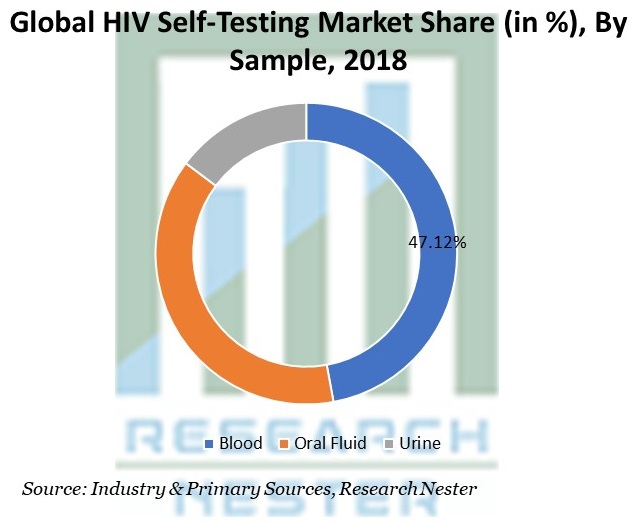HIV Self-Testing Market Overview
According to the statistics by the Avert Organization, in the year 2018, an estimated 37.9 million of the world’s population were living with HIV. These population size also included 1.7 million children.
The growth of the global HIV self-testing market is thriving on the back of growing prevalence of HIV across the world, which continues to be a burden for nations around the globe, and has created an upsurge in the requirement of advanced testing and diagnosis methods. Additionally, growing opportunities observed in making HIV kits available in several nations where there are no policies for HIVST. Moreover, with the increasing public sector funding and collaborations is helping to scale up the adoption of HIV kits in several developed and developing countries across the globe. The global HIV self-testing market is also anticipated to grow rapidly on the back of increasing penetration of online channel for the distribution of these medical products which doesn’t require local government approvals and is therefore finding massive response from the low- and middle-income nations.
The global HIV self-testing market reached USD 44.36 million in the year 2018 and is expected to garner USD 1040.99 million by the end of 2025 by registering a CAGR of 45.62% across the globe over the forecast period 2020-2025. Further, the worldwide market of HIV self-testing market is anticipated to achieve a Y-o-Y growth rate of 40.77% in the year 2025 as compared to the previous year.
Growth Highlights based on Region during 2018-2025
The global HIV self-testing market is segmented by regions into North America, Latin America, Europe, Asia-Pacific and Middle East and Africa. The HIV self-testing market in South East Asia was valued at USD 2.21 million in the year 2018 and is anticipated to attain a CAGR of 50.74% during the forecast period. The growth of the market in the region can be attributed to the presence of nations, such as Thailand and Cambodia, which are recorded to be the centers of the HIV epidemic. According to the Global AIDS Epidemic report by the UNAIDS and World Health Organization (WHO), around 0.3% of the adults in South East Asia are infected with HIV. Moreover, the HIV self-testing market in Latin America is anticipated to reach a value of USD 51.24 million in the year 2025 owing to the presence of nations, such as Brazil, which has the highest prevalence of HIV. Additionally, availability of advanced treatment facilities for HIV in the nation is also anticipated to foster the growth of HIV self-testing in the region.
The study further incorporates Y-O-Y Growth, demand & supply and forecast future opportunity in North America (United States, Canada), Latin America (Brazil, Mexico, Argentina, Rest of LATAM), Europe (U.K., Germany, France, Italy, Spain, Hungary, BENELUX [Belgium, Netherlands, Luxembourg], NORDIC [Norway, Denmark, Sweden, Finland], Poland, Russia, Rest of Europe), Asia-Pacific (China, India, Japan, South Korea, Malaysia, Indonesia, Taiwan, Hong Kong, Australia, New Zealand, Rest of Asia-Pacific), Middle East and Africa (Israel, GCC [Saudi Arabia, UAE, Bahrain, Kuwait, Qatar, Oman], North Africa, South Africa, Rest of Middle East and Africa).
Market Segmentation Synopsis
By Sample
The global HIV self-testing market has been segmented on the basis of sample into blood, oral fluid and urine. Blood segment with 47.12% share in the year 2018, occupies the largest market of HIV self-testing across the globe. The HIV tests are usually conducted using the blood samples and these types of test often deliver accurate results. Although, the results of the tests may be invalid at times owing to incorrect use of buffer, insufficient specimen and others, but among all the other samples used for HIV self-testing, blood is considered to provide the most accurate results. Additionally, the blood segment is anticipated to cross USD 480.10 million by the end of 2025 and is anticipated to flourish at a CAGR of 45.18% over the forecast period.

Market Drivers and Challenges
Growth Indicators
According to the Global AIDS Epidemic report by the UNAIDS and World Health Organization (WHO), around 1.7 million people have been affected newly by HIV in the year 2018 and that nearly 770,000 people have died of AIDS.
Growing concern for AIDS amongst people around the globe is raising the need amongst individuals to test for HIV in a private environment and further get test results immediately. The HIV self-testing kits have been introduced recently in nations across the globe which permit the use of self-testing kits. The need to scale up rapid diagnostic test volume is thereby anticipated to drive the growth of the global HIV self-testing market. Additionally, several nations are developing self-testing policies and are investing to procure such self-testing kits. Major purchase of these kits has been observed from the public sector owing to the cost factor of the product. Besides, governments of several nations around the world are also promoting the use of HIV self-testing kits, which is also anticipated to drive the growth of the global HIV self-testing market.
Barriers
Although the accuracy of HIV self-testing kits is stated to be high, doctors yet prefer their patients to be checked in the hospitals through diagnostic equipment which is anticipated to have better results. Moreover, the availability of the product is quite low in pharmacies of low- and middle-income countries, which is anticipated to hamper the growth of the global HIV self-testing market. Additionally, factors such as low awareness among people for HIV self-testing, donor funded market for single product, limited choices for consumers, reduction in supply security, lengthy registration process for approval of locally manufactured products are some of the factors anticipated to hamper the growth of the global HIV self-testing market.
Top Featured Competitive Landscape
Some of the affluent industry leaders in the global HIV self-testing market are OraSure Technologies, Inc., Chembio Diagnostics, Inc., WAMA Diagnostica, ECO Diagnostica, Orange Life and Ebram Produtos Laboratoriais Ltda.

